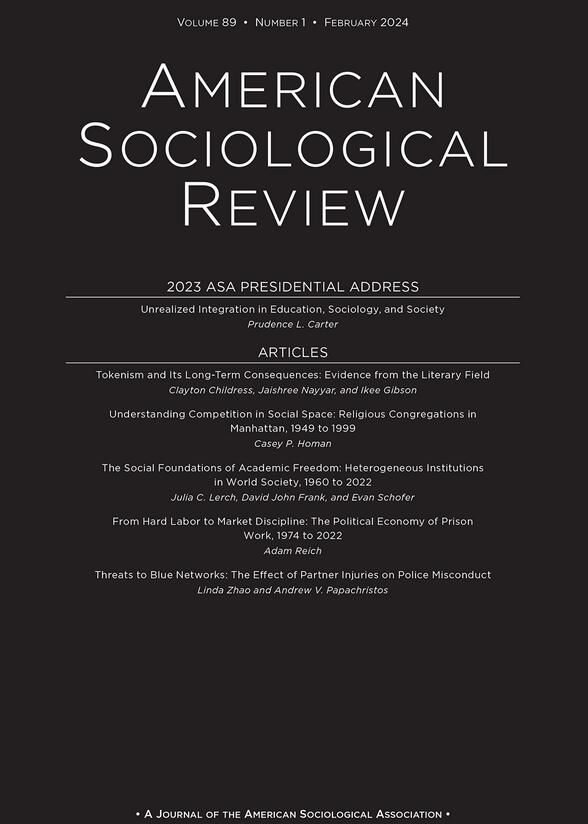种族和性别态度的交集,1977年至2018年
IF 6.2
1区 社会学
Q1 SOCIOLOGY
引用次数: 12
摘要
跨学科学者早就发现了种族和性别意识形态的动态配置。然而,对种族和性别态度的调查研究往往将这些组成部分视为独立的。我们将潜在阶级分析应用于综合社会调查(1977年至2018年)中的一组种族和性别态度项目,以确定个人对种族和性别的同时看法的四种配置。其中两种组合持有统一的进步或倒退的种族和性别态度。另外两种形式的种族和性别态度不一致,一方面的进步观点与另一方面的倒退观点相结合。在大多数调查年中,最常见的组合支持性别平等,但支持新的种族主义观点,将种族差异归因于文化缺陷。自1977年以来,这种观点变得越来越普遍,在白人女性和白人男性中最为普遍,可能是由于种族群体的利益。相比之下,黑人女性和黑人男性更有可能接受进步的种族和性别态度。我们认为,白人男性的性别平等主义可能植根于自身利益,旨在通过亲密关系获取资源。相比之下,黑人男性采取进步的种族和性别态度,与黑人女性组成必要的联盟,挑战种族主义。本文章由计算机程序翻译,如有差异,请以英文原文为准。
The Intersection of Racial and Gender Attitudes, 1977 through 2018
Intersectionality scholars have long identified dynamic configurations of race and gender ideologies. Yet, survey research on racial and gender attitudes tends to treat these components as independent. We apply latent class analysis to a set of racial and gender attitude items from the General Social Survey (1977 to 2018) to identify four configurations of individuals’ simultaneous views on race and gender. Two of these configurations hold unified progressive or regressive racial and gender attitudes. The other two formations have discordant racial and gender attitudes, where progressive views on one aspect combine with regressive views on the other. In the majority of survey years, the most commonly held configuration endorsed gender equality but espoused new racialist views that attributed racial disparities to cultural deficiencies. This perspective has become increasingly common since 1977 and is most prevalent among White women and White men, likely due to racial-group interest. Black women and Black men, in contrast, are more likely to embrace progressive racial and gender attitudes. We argue that White men’s gender egalitarianism may be rooted in self-interest, aimed at acquiring resources through intimate relationships. In contrast, Black men adopt progressive racial and gender attitudes to form a necessary coalition with Black women to challenge racism.
求助全文
通过发布文献求助,成功后即可免费获取论文全文。
去求助
来源期刊

American Sociological Review
SOCIOLOGY-
CiteScore
13.30
自引率
3.30%
发文量
35
期刊介绍:
The American Sociological Association (ASA) is a non-profit membership association established in 1905. Its mission is to advance sociology as a scientific discipline and profession that serves the public good. ASA is comprised of approximately 12,000 members including faculty members, researchers, practitioners, and students in the field of sociology. Roughly 20% of the members work in government, business, or non-profit organizations.
One of ASA's primary endeavors is the publication and dissemination of important sociological research. To this end, they founded the American Sociological Review (ASR) in 1936. ASR is the flagship journal of the association and publishes original works that are of general interest and contribute to the advancement of sociology. The journal seeks to publish new theoretical developments, research results that enhance our understanding of fundamental social processes, and significant methodological innovations. ASR welcomes submissions from all areas of sociology, placing an emphasis on exceptional quality.
Aside from ASR, ASA also publishes 14 professional journals and magazines. Additionally, they organize an annual meeting that attracts over 6,000 participants. ASA's membership consists of scholars, professionals, and students dedicated to the study and application of sociology in various domains of society.
 求助内容:
求助内容: 应助结果提醒方式:
应助结果提醒方式:


